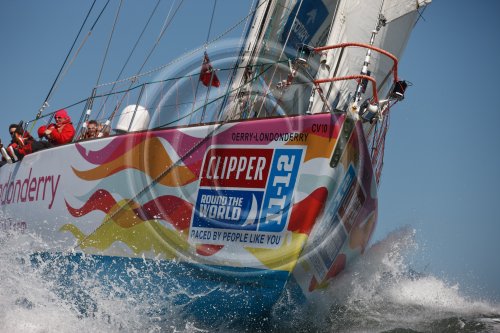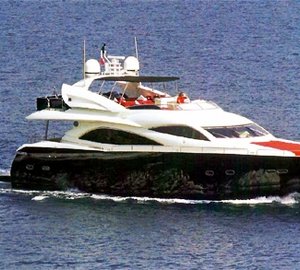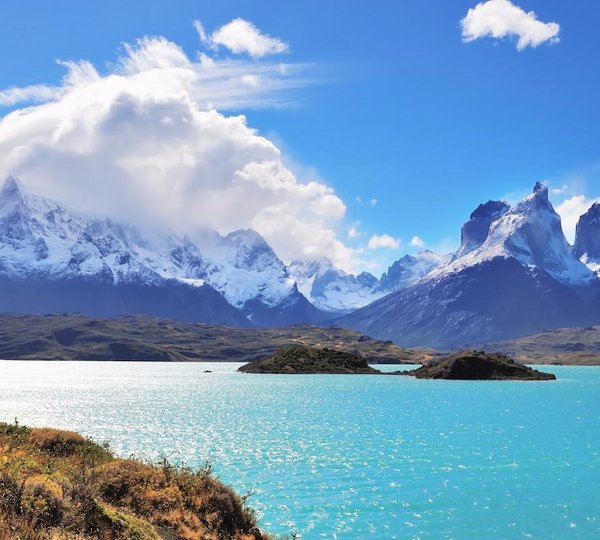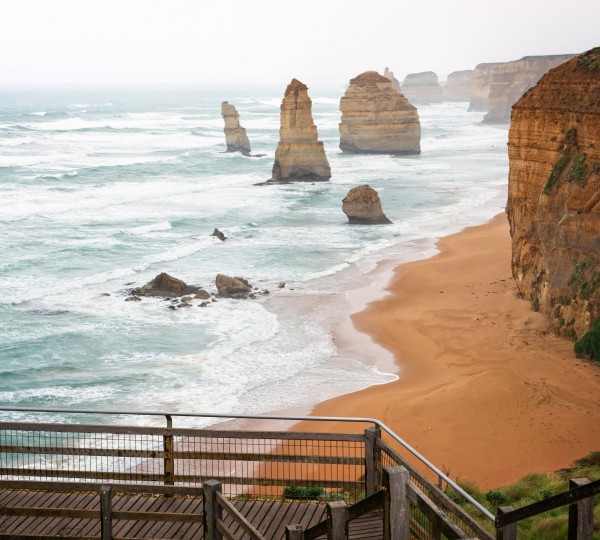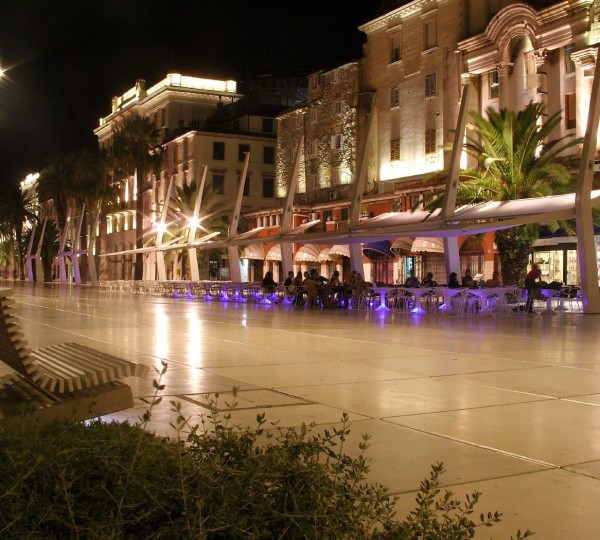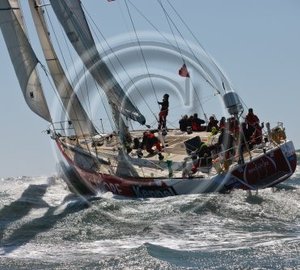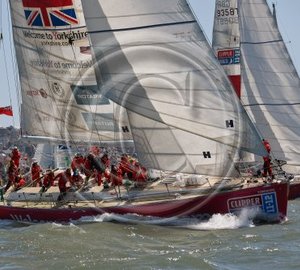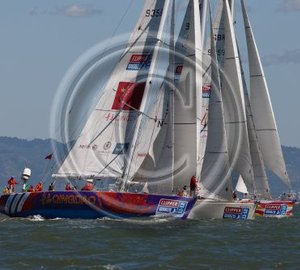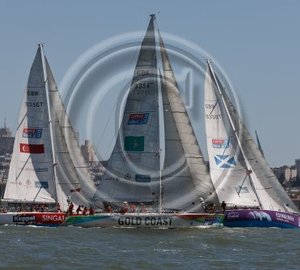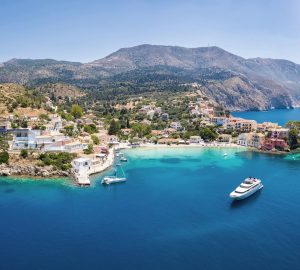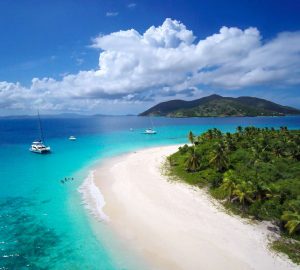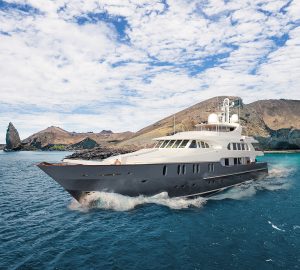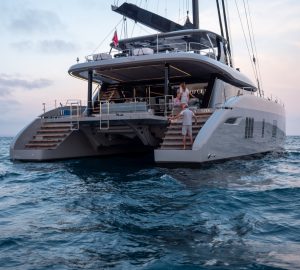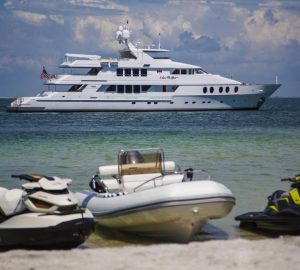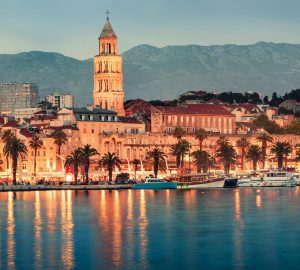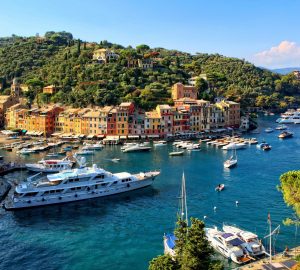Five days into the race from Oakland to Panama, the ten 68-foot yachts are only 29 miles of distance from the finish line of the Clipper 11-12 Round the World Yacht Race, the world’s longest yacht race. They are spread in a line around 140 miles long running from south west to north east.
De Lage Landen remains in the lead after decision to pass to the east of the island of Guadalupe off the Mexican coast.
“It seems that we were the only boat to sail east of the island of Guadalupe but we emerged with our position intact,” reports skipper, Stuart Jackson. “I decided to continue the shortest course from our inshore position towards the Scoring Gate and, despite concerns about light airs in the lee of the island, we managed to keep our momentum going with the lightweight spinnaker. However, only 22 miles separate the top eight boats in the fleet so I’m sure we will see lots of changing positions.”
Gold Coast Australia has slid down the leader board after the team underestimated the wind shadow in the lee of the island.
“The decision was made to take the western side after the wind picked up after sunset last night and the boat felt a bit too loaded up steering the angles required to pass the island to the east,” says Richard Hewson.
“At sunrise Guadalupe loomed in the sea mist and cloud and as the day warmed up we got a good look at the rugged, mountainous island as we sailed 15nm along its western coast. After we passed south of the island a tactical error was made when we thought we were out of the lee of the island. As a result the wind dropped from the 18 knots that the rest of the fleet was sailing in to ten knots. To add to the error the wind backed, leaving us no choice but to sail to the east.
“The rest of the afternoon was spent trying to sail out of the lee of the island, losing many miles to the other leading yachts. Finally at sunset the wind picked back up and veered to its predicted direction and we are sailing well, trying to make up lost ground.
“At the moment the fleet is very close and we can see five other yachts in our vicinity giving us good motivation to sail well throughout the night as we set ourselves up for the next light wind phase of the race.”
While Gold Coast Australia battles to get back into a podium position as the distances between the yachts get smaller, Derry-Londonderry’s crew have been enjoying the “magical conditions” and working their way into second place.
“We had been flying our medium kite, ‘Jack’ (the ripper), all day before the wind finally started to decrease once we passed the Isla de Guadalupe. This happened just as the sun was setting and we performed a textbook spinnaker peel down to our lightweight kite. A spinnaker peel is probably the most advanced sailing evolution there is and it is great to see an evolution with such a high capacity for error being executed precisely and quickly. It has also given us the chance to carry out a few running repairs, patching a couple of small holes in ‘Jack’ and repairing a spinnaker guy.
“We have managed to force our way up into second place and feel that we are in a great position to push and challenge for top spot. But with the wind decreasing as we push ever south we may need a little bit of luck from the wind gods themselves.”
The wind is likely to ease off today and bring light conditions to the fleet for the next 36 to 48 hours before filling in again. The trick will be to find the corridors of breeze to maintain momentum towards the finish line and each of the teams’ tacticians believe they know where best to find it – from De Lage Landen in the east to Edinburgh Inspiring Capital furthest to the west, where they may well find the breeze holds up for longer.
Rupert Dean, the skipper of Welcome to Yorkshire, comments on the varying tactics of the other yachts which, he says, are split into three groups.
“Today it is the west that has done the best, followed by De Lage Landen in the east, in terms of miles sailed towards the finish. This is because there appears to be a little more of a pressure gradient here compared to the centre. Much of this is due to the proximity of Guadalupe and which, although small, is mountainous and has its own wind shadow to the south south east. This particularly affected Gold Coast Australia which has been racing in sight of us. This morning she ‘hardened up’ on port gybe, sailing into this windless zone, before gybing back onto starboard to fall behind us this afternoon. Since then, we’ve both been heading south east on port, heading for the Scoring Gate with what little wind we have.
“Meanwhile on deck, we’ve been sailing under clear sunny and starry skies. Temperatures continue to rise and this evening we saw the most amazing meteor burst through the atmosphere. It doesn’t matter how many years one spends at sea, for Mother Nature still has the capacity to surprise.”
Singapore continues to pursue a central course among the fleet and is neck and neck with New York.
“Another excellent day on the water punctuated by several kite evolutions to keep everyone just busy enough,” reports Ben Bowley. “Although we have been sailing now for only a few days it feels like weeks and everyone has settled nicely into the routine of life aboard. We have positioned ourselves well for our run into the Scoring Gate and now hope that we can keep in the slightly stronger band of wind out west long enough to pull some ground in on our rivals. A special well done today to our nipper, James Thomas, for spending over an hour up the rig today with an angry kite nipping at his heels to sort out our top spreader end cap protection. Fingers crossed the wind holds for long enough for us to make it to the gate before dying out completely!”
That is the fervent hope of Gareth Glover and his team. The skipper of the American entry says, “The north westerly winds keep us heading south towards the Scoring Gate and, as we sailed past Guadalupe, Singapore passed half a mile behind us on starboard gybe. We had a good chat on the VHF and went on our way. Just as we got to the south of the island Visit Finland came into view as they gybed over in front of us. There is still over 300nm to go until we get to the Scoring Gate and we must try to keep New York moving in the light airs to come in the next few days.
“This morning we wrapped the medium weight kite around the forestay as we were trying to sail too deep downwind. One of the crew had to go to the end of the pole to it sort out and a new kite was back up in less than 20 minutes.”
Yesterday Edinburgh Inspiring Capital’s crew had a few issues as they tried to be a little too hasty in their desire to beat the other teams. Today it is the turn of Qingdao, who decided to stay offshore to avoid any wind shadows around Guadalupe. How many of us have been in the situation where a minor error leads to a bigger mistake and another one and before you know it, the only way out is to stop and start all over again?
Ian Conchie describes what happened when a spinnaker evolution started badly and just got worse.
“All was going well until at sunset the wind picked up a little bit. To look after our medium weight kite I decided to change to the heavy, even though I thought the wind would only last a short while. The first drop went fine but as we hoisted the heavyweight kite we realised it had been packed wrongly so we had to drop it quickly. During the drop it went into the sea so we had to let the halyard go and stop the boat to recover it, but we managed to do this quickly so the sail wasn’t damaged. We did manage to bend a stanchion post though. (There goes our perfect maintenance budget I fear.)
“We quickly repacked it and hoisted it again, only to get the halyards tangled, but we were able to fly it while we sorted out the boat and, two hours after we started it all, we smoothly changed back to the medium weight! All in all hard work but hopefully we didn’t lose much time to the other boats.”
Visit Finland’s crew have been dealing with spinnaker issues of their own and the old Clipper Training mantra ‘Chafe is the enemy’ is coming back to haunt them.
Olly Osborne explains, “Things have not been altogether ideal for us during the last 24 hours having suffered from a series of problems with our spinnaker gear which forced us to drop our spinnaker for some time whilst we made repairs to sails and running rigging. The continual downwind sailing puts a lot of strain on the ropes and poles and it is very surprising how quickly they can chafe through.”
Meanwhile Geraldton Western Australia’s sail repairer has been pressed into action after they spotted a rip in their lightweight spinnaker.
“A small tear was noticed in the light weight kite, so a change to the medium was required – followed-on by a gybe. Taking the long way around the Isla de Guadalupe has been our strategy today as we thought the wind may have been lighter around the island,” says Juan Coetzer.
“Everyone on board is doing really well, contributing to our boat’s speed and success in some way.”
Stuart Jackson concludes, “It has been a pretty perfect day on board with beautiful sunshine by day and an awesome light show by night. We are still being accompanied by scores of dolphins, we were treated to fresh tuna for dinner, and after more than 30,000 miles of racing we discovered one of our crew could bake excellent Belgian chocolate cake.”
The Clipper Race crews never fail to surprise with their hidden talents. People from all walks of life and more than 40 countries have signed up to the challenge of a lifetime, pushing their mental and physical boundaries further than they ever thought possible.
Who thinks to have what it takes to become a Clipper Race crew member, berths are available now for Clipper 13-14, the ninth edition of the event which will see the introduction of a brand new 12-strong fleet of 70-foot yachts.

